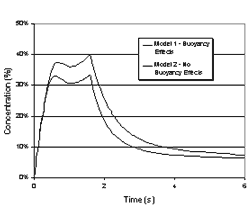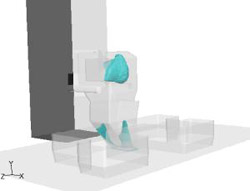|
In nuclear processes world wide, the generation of hydrogen and the subsequent management of the hazard is key to the safe operation of the plant. The behaviour of hydrogen-air mixtures is complex due to high buoyancy forces imparted by the evolving hydrogen. For safety case submissions the key sensitivities in the engineering models must be assessed. RCEL procedures ensure that important physical phenomena are understood.

Figure 1: Maximum hydrogen concentrations in an air-vented silo.
To illustrate this approach; two simulations were carried out with the Fluent CFD code to investigate the transient dispersion of a fixed volume of hydrogen released over several seconds into a moderately vented silo. Figure 1 shows the difference in the simulations for predicted peak hydrogen concentrations.
In one case the effect of turbulent diffusion is over-predicted by not activating the buoyancy term, leading to higher predicted hydrogen concentrations. These higher concentrations would have a significant impact on any subsequent analysis investigating over-pressures due to possible ignition.

Figure 2: Volume of hydrogen-air mixture at >1% hydrogen concentration.
Having gained an understanding of the key physical processes an appropriate methodology can then be implemented on plant. Figure 2 shows the volume of hydrogen-air mixture for a particular release event investigated in radioactive waste packaging building.
|
![[IMAGE] Site Location](../img/consulting.gif)

